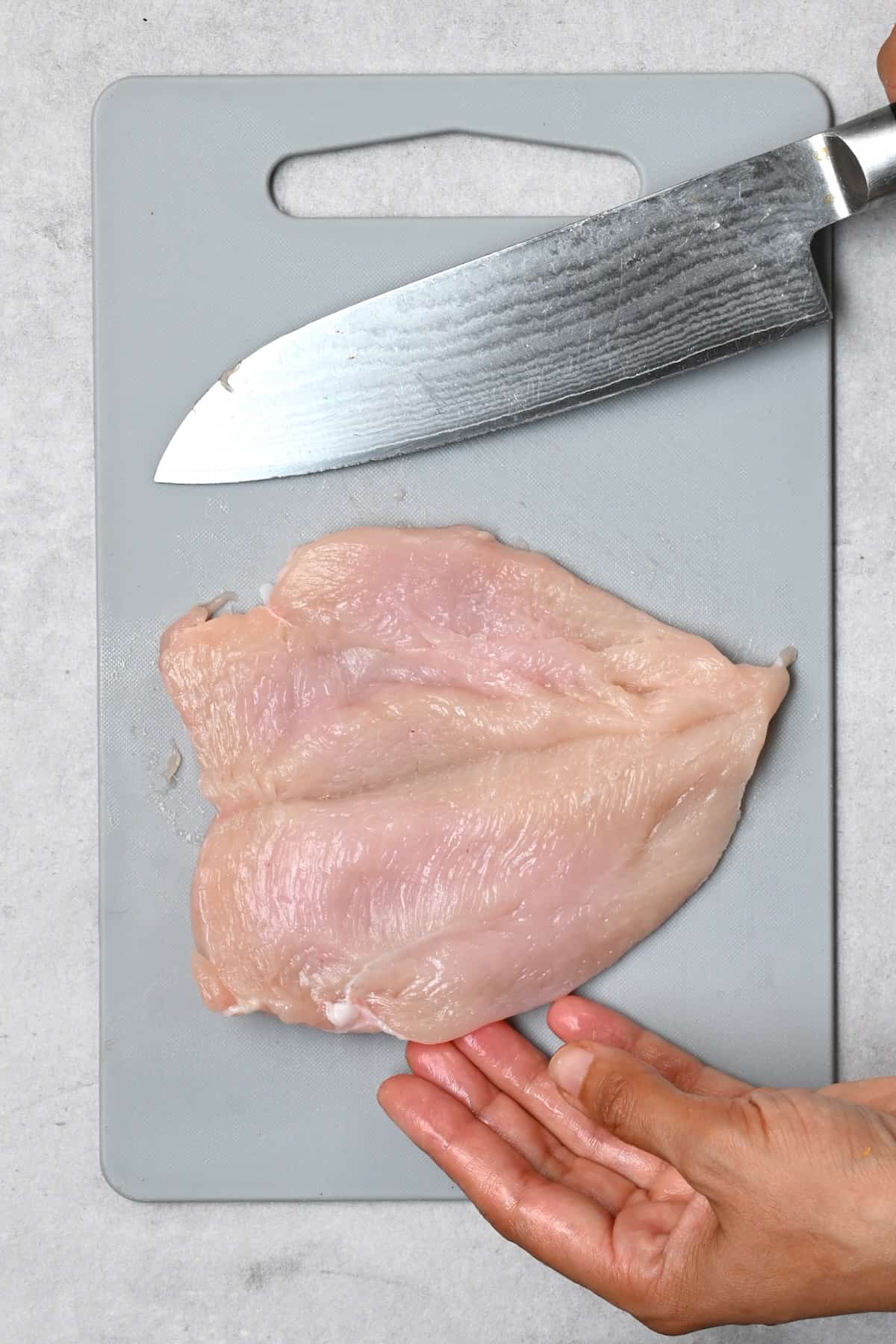This post may contain affiliate links. Please read our disclosure policy.
Learn how to butterfly a chicken breast with simple step-by-step instructions – perfect for quick cooking, stuffing, and more!

Want to save this recipe?
Why Do You Butterfly a Chicken Breast?
Learning how to butterfly a chicken breast is a useful kitchen method for any meat-eating home cook. Butterflying a chicken breast is a technique used to split meat – in this case, chicken – to create thinner pieces.
This method of butterflying is popular for many proteins – including turkey breasts, shrimp, pork, lamb, and veal, too!
These thinner sliced pieces – called “paillards” – not only cook far quicker and more evenly (great for busy weeknights), but they’re ideal for creating chicken cutlets (when cut all the way through), stuffed chicken (like chicken cordon bleu), chicken roulade, chicken piccata, etc. You can also use this method to slice thin, even chicken strips.

What You Will Need
- Chicken breasts: Use boneless, skinless chicken breasts to avoid excess prep work.
- Long sharp knife: Long enough to slice through the side of the chicken breasts. A boning knife is ideal, but a chef’s knife or a paring knife will work great, too.
- Cutting board: Non-porous materials are best for raw meat. I prefer to reserve a chopping board specifically for raw meat.
- Meat mallet: (Optional) This may be needed to pound the butterflied chicken breast flat/into even thickness. A rolling pin would also work.
- Plastic wrap/Ziplocks: (Optional) If you need to pound the chicken.

How to Butterfly Chicken Breast
First, pat the chicken breasts dry. Then place it on the cutting board with what would have been skin-side down/tenderloin-side down.
If the chicken breast has skin, loosen it with your fingers and pull it away from the breast/s.
Placing the palm of your hand flat on top of the chicken (to hold it steady), use your other hand to hold the knife parallel to the cutting board and make a single long, smooth cut horizontally through the middle of the chicken breast, ensuring you stop about ½-inch before cutting entirely through the meat.

I find it easiest to start the cut at the thicker end of the breast, slicing across and downwards towards the thin point/tip of the chicken as I slice.
Open the butterflied chicken (like a book or, rather, a butterfly shape) and check it has an even thickness. If not, place a layer of plastic wrap over the meat (or place it in a Ziplock bag) and use a meat mallet to pound the breast meat to a uniform thickness (usually about ¼-inch thick).

More Chicken How-Tos
- Homemade chicken stock
- How to Make Chicken Meatballs
- How to cook chicken breast in an air fryer
- How to grill chicken thighs
- Instant Pot chicken breast
- How to brine a whole chicken
- How to cut chicken wings
If you try this easy method for how to butterfly chicken breasts, let me know how it goes in the comments below. I’d appreciate a recipe card rating and would love to see your recipe recreations – tag me on Instagram @Alphafoodie!

How to Butterfly a Chicken Breast
Ingredients
- 2 chicken breasts or as many as needed; boneless, skinless works best
Instructions
- Pat the chicken breasts dry. Place it on the cutting board with what would have been skin-side down/tenderloin-side down.If the chicken breast has skin, loosen it with your fingers and pull it away from the breast/s.
- Placing one hand flat on top of the chicken (to hold it steady), use your other hand to hold the knife parallel to the cutting board and make a single long, smooth cut horizontally through the middle of the chicken breast, ensuring you stop about ½-inch before cutting entirely through the meat.I find it easiest to start the cut at the thicker end of the breast, slicing across and downwards towards the thin point as I slice.

- Open the butterflied chicken (like a book or, rather, a butterfly shape) and check it has an even thickness. If not, place a layer of plastic wrap over the meat (or place it within a Ziplock bag) and use a meat mallet to pound it to an even thickness (usually about ¼-inch thick).
Notes
Nutrition
Nutrition information is automatically calculated, so should only be used as an approximation.













